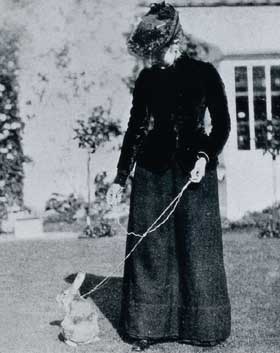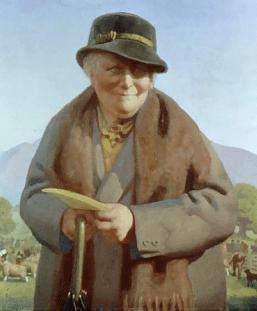Helen
Beatrix Potter (28 July 1866 – 22 December 1943) was an English author,
illustrator, mycologist, and conservationist who was best known for her
children’s books, which featured animal characters such as Peter Rabbit.
Born
into a privileged household, Potter was educated by governesses, and grew up
isolated from other children. She had numerous pets and through holidays in
Scotland and the Lake District developed a love of landscape, flora and fauna,
all of which she closely observed and painted. As a young woman her parents
discouraged intellectual development, but her study and paintings of fungi led
her to be widely respected in the field of mycology. In her thirties Potter
published the highly successful children’s book The Tale of Peter Rabbit, and
became secretly engaged to her publisher, Norman Warne, causing a breach with
her parents, who disapproved of his social status. Warne died before the wedding
could take place.
Potter
eventually published 23 children’s books, and having become financially
independent of her parents, was able to buy a farm in the Lake District, which
she extended with other purchases over time. In her forties she married a local
solicitor, William Heelis. She became a sheep breeder and farmer while
continuing to write and illustrate children’s books. Potter died in 1943, and
left almost all of her property to The National Trust in order to preserve the
beauty of the Lake District as she had known it, protecting it from developers.
Potter’s
books continue to sell well throughout the world, in multiple languages. Her
stories have been retold in various formats, including a ballet, films and in
animation.
Beatrix
Potter was born in South Kensington, London on 28 July 1866. Educated at home by
a succession of governesses, she had little opportunity to mix with other
children. Even her younger brother, Bertram, was rarely at home; he was sent to
boarding school, leaving Beatrix alone with her many pets. She had frogs, newts,
ferrets and even a pet bat. She also had two rabbits — the first was Benjamin,
whom she described as “an impudent, cheeky little thing”, while the second
was Peter, whom she took everywhere with her, even on the occasional outings, on
a little lead. Potter would watch these animals for hours on end, sketching
them. Gradually the sketches became better and better, developing her talents
from an early age.
Beatrix
Potter’s father, Rupert William Potter (1832–1914), although trained as a
barrister, spent his days at gentlemen’s clubs and rarely practiced law. Her
mother, Helen Potter née Leech (1839–1932), the daughter of a cotton
merchant, spent her time visiting or receiving visitors. The family was
supported by both parents’ inherited incomes.
Every summer, Rupert Potter would rent a country house; firstly Dalguise House in Perthshire, Scotland for the eleven summers of 1871 to 1881, then later one in the English Lake District.

Beatrix Potter with pet rabbit,
Benjamin Bouncer (September 1891)
In
1882 the family met the local vicar, Canon Hardwicke Rawnsley, who was deeply
worried about the effects of industry and tourism on the Lake District. He would
later found the National Trust in 1895, to help protect the countryside. Beatrix
Potter had immediately fallen in love with the rugged mountains and dark lakes,
and through Rawnsley, learnt of the importance of trying to conserve the region,
something that was to stay with her for the rest of her life.
When
Potter came of age, her parents appointed her their housekeeper and discouraged
any intellectual development, instead requiring her to supervise the household.
From the age of 15 until she was past 30, she recorded her everyday life in
journals, using her own secret code that was not decoded until 20 years after
her death.
An
uncle attempted to introduce her as a student at the Royal Botanic Gardens at
Kew, but she was rejected because she was female. Potter was later one of the
first to suggest that lichens were a symbiotic relationship between fungi and
algae. As, at the time, the only way to record microscopic images was by
painting them, Potter made numerous drawings of lichens and fungi. As the result
of her observations, she was widely respected throughout England as an expert
mycologist. She also studied spore germination and life cycles of fungi.
Potter’s set of detailed watercolors of fungi, numbering some 270 completed by
1901, is in the Armitt Library, Ambleside.
In
1897, her paper on the germination of spores was presented to the Linnean
Society by her uncle Sir Henry Enfield Roscoe, as women were barred from
attending meetings. (In 1997, the Society issued a posthumous official apology
to Potter for the way she had been treated.) The Royal Society also refused to
publish at least one of her technical papers. She also lectured at the London
School of Economics several times.
The
basis of her many projects and stories were the small animals that she smuggled
into the house or observed during family holidays in Scotland and the Lake
District. When she was 27 and on one such holiday in Scotland, in a letter dated
4 September 1893 she sent a story about rabbits to Noel Moore, the five-year-old
son of her last governess. She was encouraged to publish the story so she
borrowed it back in 1901 and made it into the book entitled The Tale of Peter
Rabbit. However, she struggled to find a publisher for it and eventually had 250
copies printed privately. In October 1902, Frederick Warne & Co. agreed to
publish 8,000 copies in a small format, easy for a child to hold and read,
having asked Beatrix to re-illustrate it in color. It was extremely well
received and, by the end of the year, 28,000 copies had been printed.
She
followed it with The Tale of Squirrel Nutkin in 1903, which was also based on an
earlier letter. Such was the popularity of these and her subsequent books that
she gained an independent income from their sales. She also became secretly
engaged to the publisher, Norman Warne in 1905, but her parents were set against
her marrying a tradesman. Their opposition to the wedding caused a breach
between Beatrix and her parents. However, the wedding was not to be, for soon
after the engagement, Norman fell ill of pernicious anemia and died within a few
weeks. Beatrix was devastated. She wrote in a letter to his sister, Millie,
“He did not live long, but he fulfilled a useful happy life. I must try to
make a fresh beginning next year.”
